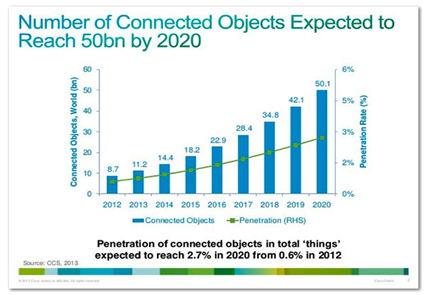At a time when organizations are looking to take advantage of big data, IOT offers an opportunity to gather even more information that could prove extremely useful to business. Internet of Things is a combination of connected objects that provides information through sensors and actuators. But by the passing year, these objects will increase considerably.
Cisco predicts that 21 billion devices will be connected by 2018. And the rest scenario can be visualized in the below chart.

Once the Internet of Things gets rolling, we will realize data sweeping at us from all directions- from machines, from power stations, from the shipping container and so on. This indeed will generate really more and more Big Data for Analysis.
Robb’s sources noted, “Every enterprise needs to factor in how the Internet of Things is going to affect them and their business and must respond by establishing the right infrastructure to support this level of Big Data and analytics. If they don’t, they will fall behind.”
Such unstructured raw data can be processed by Apache’s open-source Hadoop distributed data processing system, also by various NoSQL databases and this leaves an open door for Business Intelligence and Analytics.
Examples combining IOT with Big Data and Analytics:
- A Sushi restaurant in Japan that has RFID tags on its plates
and monitors in real time, what is been served and how fresh it is? Here they used a framework of Hadoop “Spark”. Spark builds microcontroller for connected devices as well as a cloud-based operating system for managing them and a set of tools for analyzing the data they produce. The easier it is for people to add sensors to their devices and start gathering the data, the faster we’ll see them finding their way onto everything. - In the agricultural field, a scientist must understand how much irrigation is needed for a crop under various weather conditions. IoT can provide accurate and automated data collected at very periodic intervals, of the weather, farm, and individual crop conditions, But once the data is collected, the actions that need to be taken based on the data is dependent on the domain-specific scientists.
Challenges to IOT:
A key challenge with IoT is data management: determining what type of data is important, what should be transmitted immediately, what should be stored and for how long, and what information should be discarded.
Some data just needs to be read and thrown away
This, in turn, will trigger scarcity for the specialist in building the structure for such Gigantic Data and crave to upgrade with Apache’s frameworks will be observed.
Research from Accenture shows that finding top analytics talent to manage massive amounts of data will be difficult in the years ahead. The results of a year-long research project by the firm show that the United States is projected to create nearly 39,000 new jobs for analytics experts through 2015, but will only be able to fill 23% of those roles with qualified candidates.
“Knowledge is power, and businesses that leverage IOT have the potential for an incredible competitive advantage,” Redding says.
Hence Learn how you can derive deep business insight from the Internet of Things (IoT) training by boosting your skills from a new venture of Cognixia

